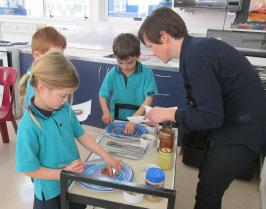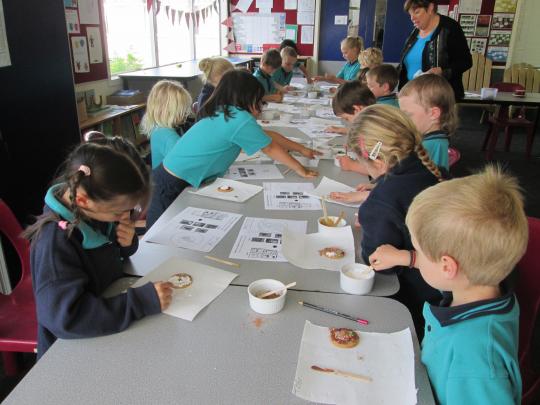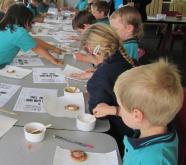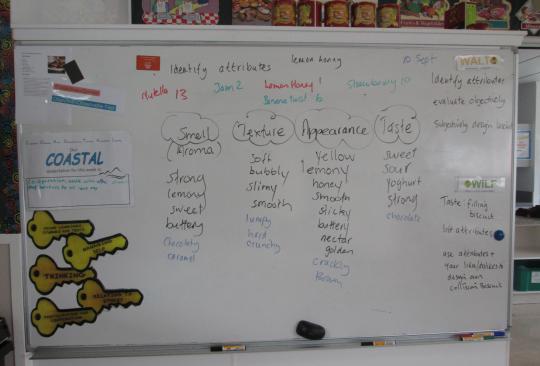Introducing technology to juniors
Teaching inquiry
Does adapting the Technology Online resource Is food a technological outcome? help me to effectively introduce technology to year 1–2 students?
Introduction
Coastal Taranaki School teachers Sally Laing and Marion Richardson used a Technology Online snapshot as inspiration for a food technology unit that would introduce students to the characteristics of technology component and the technological practice strand at level 1.

Sally and Marion's food technology unit supported their year 1–2 students to develop:
- understandings at level 1 for technological practice
- some understanding of the first indicator in the characteristics of technology component: identify that technology helps to create the made world
- some understandings about technological products.
Background
All junior school students at Coastal Taranaki School Okato are timetabled to come to the specialist classrooms once a week for seven weeks every term.
When the year 1–2 students were timetabled into the foods room, Sally Laing and Marion Richardson planned to use this time to introduce students to the technology curriculum, focusing on the characteristics of technology component at level 1 and introducing the technological practice strand at the same level.
The unit developed also needed to address the limited experience students had with food preparation. The Beacon Practice facilitator Paul Neveldsen suggested that the one-lesson activity developed by Dorothy Hutton as part of the Beacon Practice Phase 3 project could be a good starting point.
Teaching snapshot: Is food a technological outcome?
Sally and Marian modified the one-lesson activity into a seven-lesson unit, taking into account the extra time available, the access to the specialist classroom, and the reading and writing levels of the students.
Rather than providing the children with examples of technologists practice, they decided to encourage the children to be “technologists” and to discuss with them the things they would need to do as part of their own technological practice.
Introduction to the unit
The class watched the YouTube clip “Stuck” by Oliver Jeffers. It is a story about trying to solve a problem by throwing things at it. The story ends with a lot of objects stuck up in a tree.
The class had already talked about the made and natural world. After they had enjoyed the story, the students were asked to identify technological products from the made world and natural objects in the story. The teachers recorded the discussion on an A3 sheet.
Worksheet for Stuck (PDF, 45 KB)
The teachers showed the students the snapshot on Technology Online, looking at the outcomes produced by the students at Columba College.
Collision biscuit development
The teachers explained that the product the students would be creating was a new collision biscuit.

The students analysed existing biscuits, talked about how they were constructed, and recorded their findings on a worksheet. The class created a word bank of sensory testing vocabulary based on the words students used in the class discussion.
Collision biscuits: Descriptive words (PDF, 19 KB)
As their understandings of children’s literacy ability at this year level grew, Sally and Marion modified and simplified worksheets. They noted that at this level students needed guidance on how to add information to a chart.
Collisions biscuit worksheet: Version 1 (PDF, 75 KB)
Collision biscuits worksheet: Version 3 (PDF, 117 KB)
Students also carried out some testing to determine which fillings were the most effective in sticking the biscuits together.

Evaluation template: Fillings (Word, 29 KB)
Collision biscuits worksheet: Toppings (Word 2007, 455 KB)
Final biscuit designs were recorded using images because the students found it easier to record in this way. It was also more realistic given the timeframe. Moving the students from their regular classroom over to the practical room eroded class time and 50-minute classes often became 35-minute classes. Including a practical foods activity and recording understandings in any written detail with this year level would have been challenging in the time available.
The teachers found setting up in the same way each lesson to better transitioning for the students. A long table was set up in the room and students were allocated the same seats each lesson.

Collision biscuits worksheet: Final biscuit design (Word 2007, 2 MB)
Outcome
Overall teacher judgments put the students at level 1 for technological practice and the students had some understanding of the first indicator in the characteristics of technology component: identify that technology helps to create the made world.
The activity of designing and making their own collision biscuit was found to be manageable within the timetable constraints.
The students were able to talk about the performance properties of the various ingredients used to stick the biscuits together – so Sally and Marion recognised that they had also introduced understandings about technological products.
What next?
The teachers are looking forward to building on the routines and learning established this year.
We know to keep it simple, plan it well, minimise the writing, document learning as a whole class, get to know the students, and have fun – so they want to come to our class.
Sally Laing


